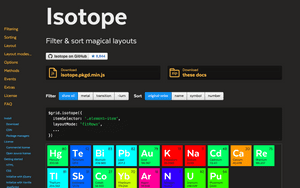
The Challenge
Isotope is a JavaScript library that can provide an animated, filterable/sortable layout for a list of HTML elements. A demo of the effect can be seen on either its official website. or the portfolio page of this same very site.
It's a quite handy tool, and the animations look cool, but the problem is that it was quite a dated library, first introduced back in the days of jQuery, hence not as well suited to be used together with a modern front end framework like React. Though the official documentation has chapters on initializing Isotope with both vanilla JS and HTML, nothing on using it with React has been given.
Previous Takes
There haven't been many discussions on this topic. Some of the top hits that a quick Google search for "isotope and react" returns are "React.js with Isotope and Flux" which is more than 3 years old and involves using an extra library,
"How to make Isotope work in a Gatsby site" which is quite new and somewhat enlightening, but simply has too many repetitive or unnecessary code. The StackOverflow question "React.js and Isotope.js" provides several interesting answers, yet again either not working anymore due to datedness or containing no longer recommended methods like ReactDOM.findDOMNode. It's certainly time for an easy, up-to-date, and most importantly a working solution.
My Approach & Solution
Below is a barebone example of my take on the problem on Codepen using useState and useEffect hooks, features newly added into React 16.8 this very year.
Firstly, we create two states with useState:
// state for storing the isotope object, with an initial value of null
const [isotope, setIsotope] = React.useState(null);
// state for storing the filter keyword, with an initial value of *, which matches everything
const [filterKey, setFilterKey] = React.useState('*');Next, we initialize Isotope with configs after the component is mounted with the first useEffect:
React.useEffect(() => {
setIsotope(
new Isotope('.filter-container', {
// filter-container: className of the parent of the isotope elements
itemSelector: '.filter-item', // filter-item: className of the isotope elements
layoutMode: 'fitRows', // for horizontal isotope
})
);
}, []); // [] makes this useEffect work like a componentDidMount in a class componentThen, we have another useEffect handling filter key change, calling the arrange method of the isotope object to reorganize the item layout when a change to the filterKey is detected:
React.useEffect(() => {
if (isotope) {
// sanity check
filterKey === '*'
? isotope.arrange({ filter: `*` })
: isotope.arrange({ filter: `.${filterKey}` });
}
}, [isotope, filterKey]);The [isotope, filterKey] makes this useEffect work like an
componentDidUpdate(prevProps, prevState) {
if (prevState.filterKey !== this.state.filterKey) {
// do the thing
}
}Last but not least, here comes:
<ul>
<li onClick={() => setFilterKey('*')}>Show Both</li>
<li onClick={() => setFilterKey('vege')}>Show Veges</li>
<li onClick={() => setFilterKey('fruit')}>Show Fruits</li>
</ul>to change the filterKey state when clicked, and:
<ul className="filter-container">
<div className="filter-item vege">
<span>Cucumber</span>
</div>
<div className="filter-item fruit">
<span>Apple</span>
</div>
<div className="filter-item fruit">
<span>Orange</span>
</div>
<div className="filter-item fruit vege">
<span>Tomato</span>
</div>
</ul>the isotope items with their respective filter keywords "fruit" and "vege".
The Results
A simple, modern solution to using isotope with React that works with both static items or dynamically generated items, you are welcome to give it a try, thank you for your time!